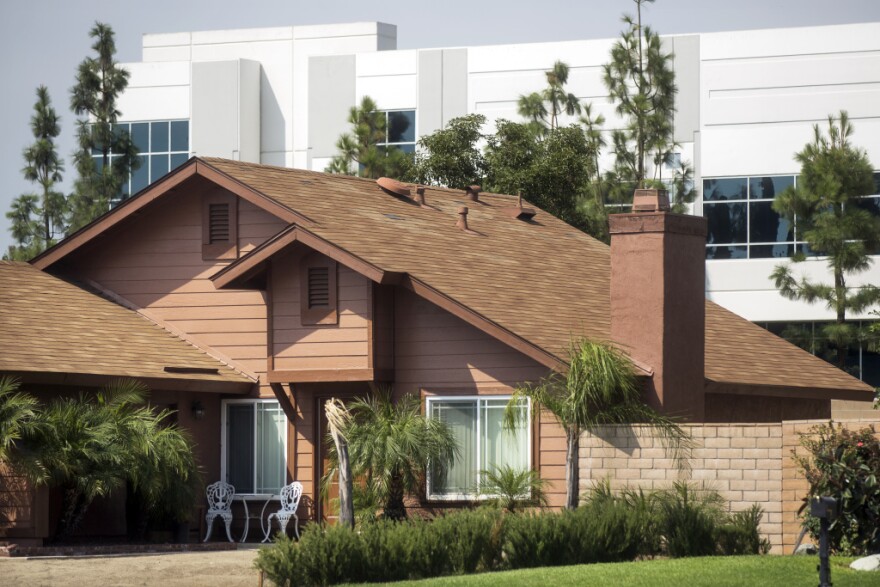Truth matters. Community matters. Your support makes both possible. LAist is one of the few places where news remains independent and free from political and corporate influence. Stand up for truth and for LAist. Make your year-end tax-deductible gift now.
The Hidden Cost of Next Day Delivery: Polluting Warehouses

Driving Interstate 10 through the Inland Empire, there are so many large, grey buildings, endlessly on the side of the freeway, it can feel like warehouses will someday cover every last acre of land.
Bloomington resident Cruz Baca Sembello has been fighting that transformation in her own semi-rural neighborhood in San Bernardino County
Sitting in the shade of her backyard patio, Sembello can look west and see trees and her neighbors’ homes on one-acre lots. She can hear roosters and some horses.
“It's very peaceful here. And in my later years, that's what I want,” Sembello said.

But when she looks east, a big warehouse next door dominates the view. It was painted a blue-ish gray, so on some days, it matches the color of the mid-day sky that it blocks. Since it went up five years ago, it’s been round-the-clock trucks, big-rig noise, and diesel emissions.
“In the middle of the night or whatever hours of the morning, the whole house starts to shake from the trucks going through there, and the sound when they’re backing up and that beeping, it’s very noisy.”
Three Million Square Feet
She inherited the place from her late parents with plans to retire there, but now those plans are in doubt. A property broker she described as “very pushy” has been hounding her to sell — so it can become part of a giant new complex of warehouses.
A developer has included her property — and that of more than 100 other families — within the boundaries of his project. He wants to change the zoning of 213 acres of rural Bloomington to industrial uses, for three million square feet of warehouses, manufacturing plants and offices.
That is about 46 football fields of interior space that would be constructed over the next 20 years.
Some neighbors have told Sembello they are happy to take the money and leave, but she wants to stay, even though she says the broker is offering her more than one million dollars.
“It's a lot of money, but at this point in my life, I don't think it's worth me giving up my peace and the way I want to live,” she said. And even if she manages to hold onto her one-story house and nearly one acre of land, she might end up with warehouses on every side.

Walking around a different portion of the neighborhood I came across Hipolito Ramos. He told me, in Spanish, that he's quite torn over whether to stay or go.
The property, which is right in the middle of the project map, cost him and a cousin a little over $250,000 in 2009. It has two houses and it’s nearly paid for, he said
Ramos doesn’t want to start all over again and he doesn’t think he can find anything like this that could house both families for the price he’s being offered.
Prime Real Estate
Why are homes in Bloomington on the brink of being absorbed by the warehouse industry? Location, mostly.
Bloomington is tucked between a triangle of cities — Fontana and Rialto in San Bernardino County and Jurupa Valley in Riverside County. It’s near the 10, 15 and 60 freeways, and convenient to Ontario International Airport and railroad lines. It’s also right along the main shipping routes for goods that come into the ports of Los Angeles and Long Beach to the rest of the country.
People want their stuff tomorrow, if not today.
And that’s key, because of the growth of online shopping and the demand for quick delivery, said UC Riverside professor Juliann Emmons Allison, who studies sustainability and environmental policy.
“People want their stuff tomorrow, if not today,” she said. “So there's an inevitability to it being here.”
Warehouse developers have nearly exhausted the supply of vacant land near the freeways and are now targeting infill parcels, including occupied areas like Sembello’s neighborhood in Bloomington.
So many warehouses have been built in Riverside and San Bernardino counties that they are now home to more than 359 million square feet of indoor warehouse space—that’s nearly 6,500 football fields.
I met Sembello through the Center for Community Action and Environmental Justice, which is organizing resistance to the warehouse plan in Bloomington and throughout the Inland region. Community organizer Faraz Rizvi said Riverside and San Bernardino counties are big targets for the logistics industry.
“The Inland Empire, I mean, it's cheap labor, it's cheap land, and it's a lot of space,” Rizvi said. “So for warehousing, it's the perfect kind of crux of issues that kind of allows for this area to be prime real estate for them.”
I ask him what they are fighting for, if it seems inevitable that warehouses will cover the area. He doesn’t concede that warehouses will win the turf war for land.
“The communities here don't like it. They don't want it. And they should have a voice in the proceedings that happen. And we're going to continue to fight for that no matter what.”
Environmental and Spatial Justice
Warehouses are not distributed evenly across Southern California. They are clustered around freeways, especially in poorer areas where land and labor cost less. And because of those concentrations, some environmental justice advocates are arguing that the cumulative effects of each new project should keep big new warehouses from being approved.
Juliann Emmons Allison from UC Riverside says adding new warehouses to areas like the Inland Empire is not just disproportionately hurting poor populations and communities with larger percentages of Black and Latinx residents.
It’s also a question of what she calls spatial justice, where an entire geographic region’s population bears the burden of polluting warehouses, serving other regions that don’t have as many.
“So San Diego, Orange County, and to some extent, the nicer parts of Los Angeles, have been able to enjoy good air quality and higher incomes and nicer homes and better standards of living and better schools and all of those kinds of things, because the nastiness is allowed to be in this geographic area,” she said.
“This whole region geographically is suffering from this phenomenon. And there's a sense in which we should be paid for it. We should be compensated for that (by any) warehouse that wants to come in. They need to mitigate some of this.”








